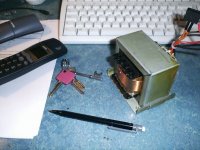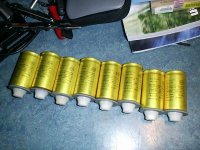OKAY!
Looks like we got a good conversation here!
I'm not building a pass-amp, just a regular LM3886 amp, (maybe bridged?). I'm not thinking of hooking up well over one F, just about 50 000 microF I think. The reason i asked is that the x-former I'm using doesn't look bigger than 100VA or so, which is why I wanted to make sure it wouldn't melt or something
Apparently it won't be a problem! Naturally I'd hook up pi filter to, if I only knew how to wire it in the PSU, I mean how do u connect it?
Thanks for all the answer! ( gonna go to work now and try to steal a nice enclosure for my new amp! )
/Chris
Looks like we got a good conversation here!
I'm not building a pass-amp, just a regular LM3886 amp, (maybe bridged?). I'm not thinking of hooking up well over one F, just about 50 000 microF I think. The reason i asked is that the x-former I'm using doesn't look bigger than 100VA or so, which is why I wanted to make sure it wouldn't melt or something
Apparently it won't be a problem! Naturally I'd hook up pi filter to, if I only knew how to wire it in the PSU, I mean how do u connect it?
Thanks for all the answer! ( gonna go to work now and try to steal a nice enclosure for my new amp! )
/Chris
One important factor when desiding how much C you need is the Power Supply Rejection Ratio (PSRR) the amp has. The ripple voltage searches the way trough the amp and eventually out to the speakers causing hum and distortion.
2 x 10000 µF for a +-45 volt supply is normal and 8 ohms. 4700 µF is a little bit too little. >22000 µF doesn't add much but can be handy when the amp is delivering transient power.
It's no harm to have a heavy smoothing battery but remember that this causes extra heat in the transformer. Thumbrule is heavy smoothing reduce the VA rating to 1/2.
Example: 100 W resistive power out (from the power supply, not the amp)=> demands for a 200 VA transformer.
2 x 10000 µF for a +-45 volt supply is normal and 8 ohms. 4700 µF is a little bit too little. >22000 µF doesn't add much but can be handy when the amp is delivering transient power.
It's no harm to have a heavy smoothing battery but remember that this causes extra heat in the transformer. Thumbrule is heavy smoothing reduce the VA rating to 1/2.
Example: 100 W resistive power out (from the power supply, not the amp)=> demands for a 200 VA transformer.
Kilowatt
"No, it will never start to sound bad, no matter how much you add on. You could out on Farads and Farads if you like."
That may be true in specific circumstances, but I know from my experience, and that of others, that too much capacitance can kill the sound.
There are numerous competing mechanisms and PSU topology will probably ultimately determine what effect they have on the end result.
Just for starters bear in mind that increasing capacitance has large effects on leakage and peak current flows within the PSU, these can easily modulate the resultant amplifier output in musically significant ways.
Andy.
"No, it will never start to sound bad, no matter how much you add on. You could out on Farads and Farads if you like."
That may be true in specific circumstances, but I know from my experience, and that of others, that too much capacitance can kill the sound.
There are numerous competing mechanisms and PSU topology will probably ultimately determine what effect they have on the end result.
Just for starters bear in mind that increasing capacitance has large effects on leakage and peak current flows within the PSU, these can easily modulate the resultant amplifier output in musically significant ways.
Andy.
Re: Kilowatt
My point of view is that leakage is totally unimportant as long as the current not generates heat inside the caps (which won't happen if the caps are allright and not takes more voltage that they can handle). If you don't exceed the current limits (which you probely don't) the caps won't have any problems to handle charging and discharging currents.
The only thing that has influence on leakage is applied DC-voltage along with age and time in service. DC voltage on a cap will reduce leakage with time as long as the voltage isn't too high.
ALW said:Just for starters bear in mind that increasing capacitance has large effects on leakage and peak current flows within the PSU, these can easily modulate the resultant amplifier output in musically significant ways.
My point of view is that leakage is totally unimportant as long as the current not generates heat inside the caps (which won't happen if the caps are allright and not takes more voltage that they can handle). If you don't exceed the current limits (which you probely don't) the caps won't have any problems to handle charging and discharging currents.
The only thing that has influence on leakage is applied DC-voltage along with age and time in service. DC voltage on a cap will reduce leakage with time as long as the voltage isn't too high.
Christian said:OKAY!
Looks like we got a good conversation here!
I'm not building a pass-amp, just a regular LM3886 amp, (maybe bridged?). I'm not thinking of hooking up well over one F, just about 50 000 microF I think. The reason i asked is that the x-former I'm using doesn't look bigger than 100VA or so, ...
If you can give me the dimensions and/or the weight of the transformer I can estimate the VA rating.
Re: Re: Kilowatt
...and don't forget that higher cap means shorter & higher current peaks (as explained by Grey above in an excellent way - great job Grey) which in turn means very sharp corners on the ripple waveform which means a lot of higher harmonics which with the lower amp PSRR will definitely have a musical impact. More caps is always good? Don't think so!
I still haven't seen ANY good reason why a cap should be greater than say 10mF. Anyone want to try?
Jan Didden
peranders said:
My point of view is that leakage is totally unimportant as long as the current not generates heat inside the caps (which won't happen if the caps are allright and not takes more voltage that they can handle). If you don't exceed the current limits (which you probely don't) the caps won't have any problems to handle charging and discharging currents.
The only thing that has influence on leakage is applied DC-voltage along with age and time in service. DC voltage on a cap will reduce leakage with time as long as the voltage isn't too high.
...and don't forget that higher cap means shorter & higher current peaks (as explained by Grey above in an excellent way - great job Grey) which in turn means very sharp corners on the ripple waveform which means a lot of higher harmonics which with the lower amp PSRR will definitely have a musical impact. More caps is always good? Don't think so!
I still haven't seen ANY good reason why a cap should be greater than say 10mF. Anyone want to try?
Jan Didden
Tja PerAnders!
It looks like this, I placed some objects around it so u could better etimate its power. It's 9cm long, 9cm wide and 7.5 cm high.
There are two windings of about 35 Volts, and an additional winding of 8V that was used to power som leds on the instrument panel of an old amp.
/ Chris
It looks like this, I placed some objects around it so u could better etimate its power. It's 9cm long, 9cm wide and 7.5 cm high.
There are two windings of about 35 Volts, and an additional winding of 8V that was used to power som leds on the instrument panel of an old amp.
/ Chris
Attachments
R U Sure?
Again I think it depends upon topology.
Consider these questions: -
a) Is the leakage current a pure DC leakage, or does it have AC content?
b) Is it possible for the current to flow in any part of the circuit that could give rise to AC errors within the signal path?
It may not be as irrelevent as you first imagine.
By far thought he harmonic noise increase from reduced conduction angles is likely to be the dominant factor, as Jan points out.
Try looking at the spectrum of the 'DC on the smoothing cap sometime - it's more likely to look like a porcupine....
Andy.
My point of view is that leakage is totally unimportant as long as the current not generates heat inside the caps
Again I think it depends upon topology.
Consider these questions: -
a) Is the leakage current a pure DC leakage, or does it have AC content?
b) Is it possible for the current to flow in any part of the circuit that could give rise to AC errors within the signal path?
It may not be as irrelevent as you first imagine.
By far thought he harmonic noise increase from reduced conduction angles is likely to be the dominant factor, as Jan points out.
Try looking at the spectrum of the 'DC on the smoothing cap sometime - it's more likely to look like a porcupine....
Andy.
If you want to get down to it, the only realistic way to talk about caps in the storage sense is to express it in Joules.
J=1/2*C*V**2 (quoting from memory, look it up to be sure)
J= Joules of energy
C= capacitance in Farads
V= volts
Note that the rail voltage is part of the equation and is squared, so it makes a big difference whether you're talking 18V or 24V rails.
Or 550V for a tube amp...
Grey
J=1/2*C*V**2 (quoting from memory, look it up to be sure)
J= Joules of energy
C= capacitance in Farads
V= volts
Note that the rail voltage is part of the equation and is squared, so it makes a big difference whether you're talking 18V or 24V rails.
Or 550V for a tube amp...
Grey
Christian said:Tja PerAnders!
It looks like this, I placed some objects around it so u could better etimate its power. It's 9cm long, 9cm wide and 7.5 cm high.
I should guess the VA rating is 100-150 VA.
70 x 108 x 83 mm = 100VA in ELFA, 2.1 kg
80 x 120 x 103 mm = 200 VA, 3.6 kg
Think also what we have said here about "VA out" you can take out 50-80 Watts continuously => 2 x 20-30 W music power. But still, if you play music I think it's OK with the transformer but maybe a little too small. If you have some control over the temperature of the transformer nothing bad can happen.
Yup, that's right, assuming you mean "^" by "**."J=1/2*C*V**2
- Status
- This old topic is closed. If you want to reopen this topic, contact a moderator using the "Report Post" button.
- Home
- Amplifiers
- Solid State
- Capacitance Limit?

